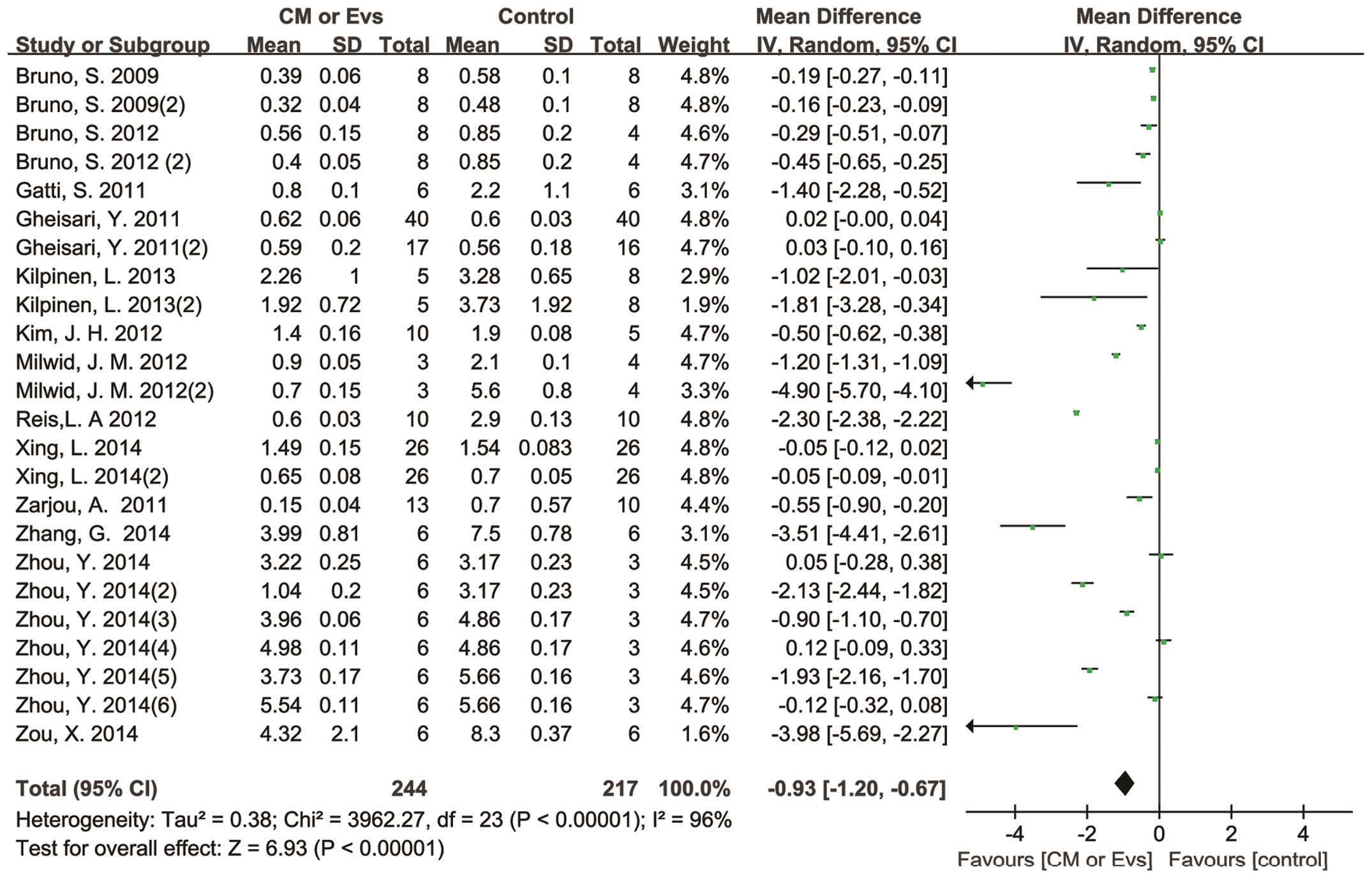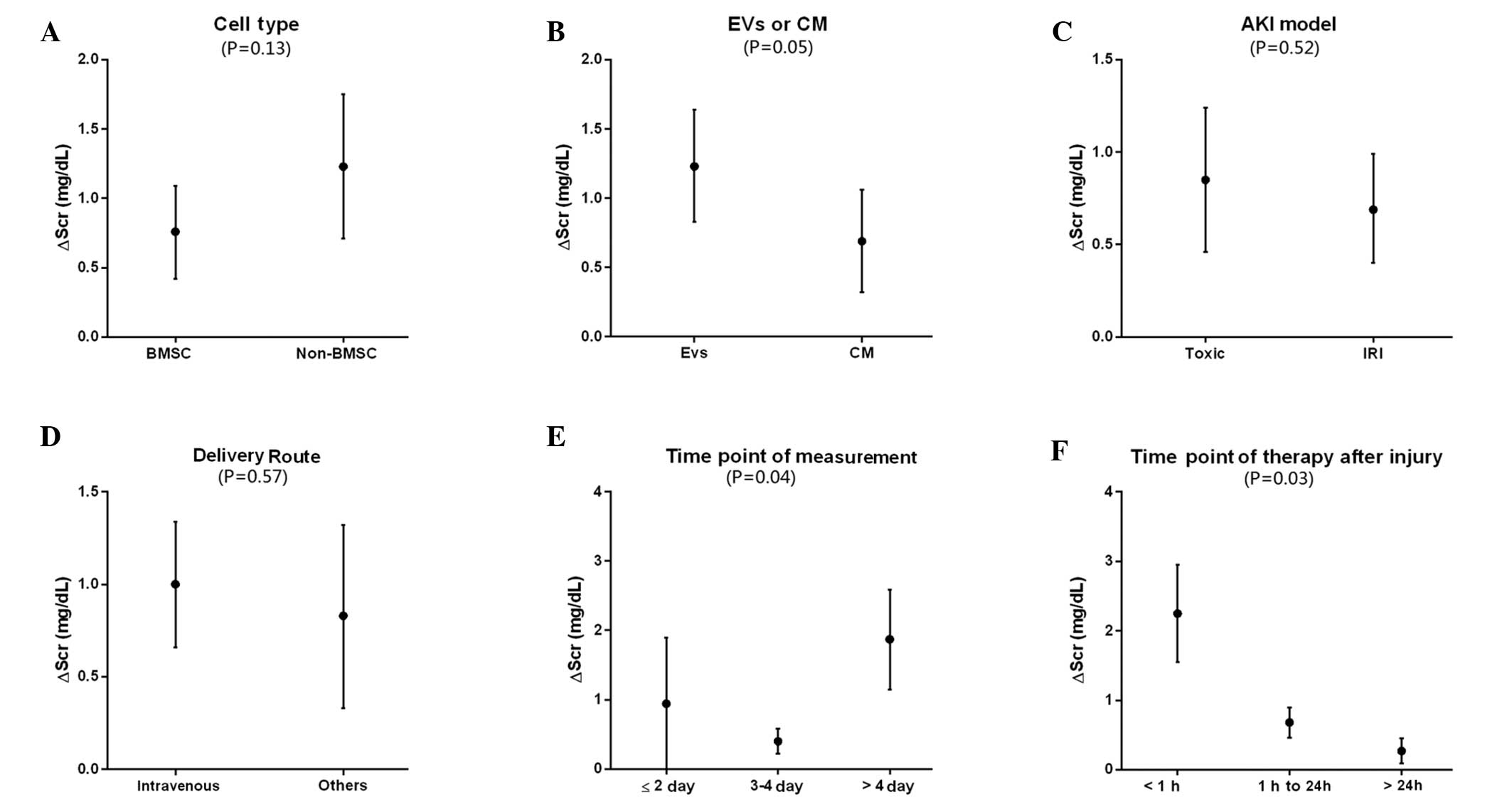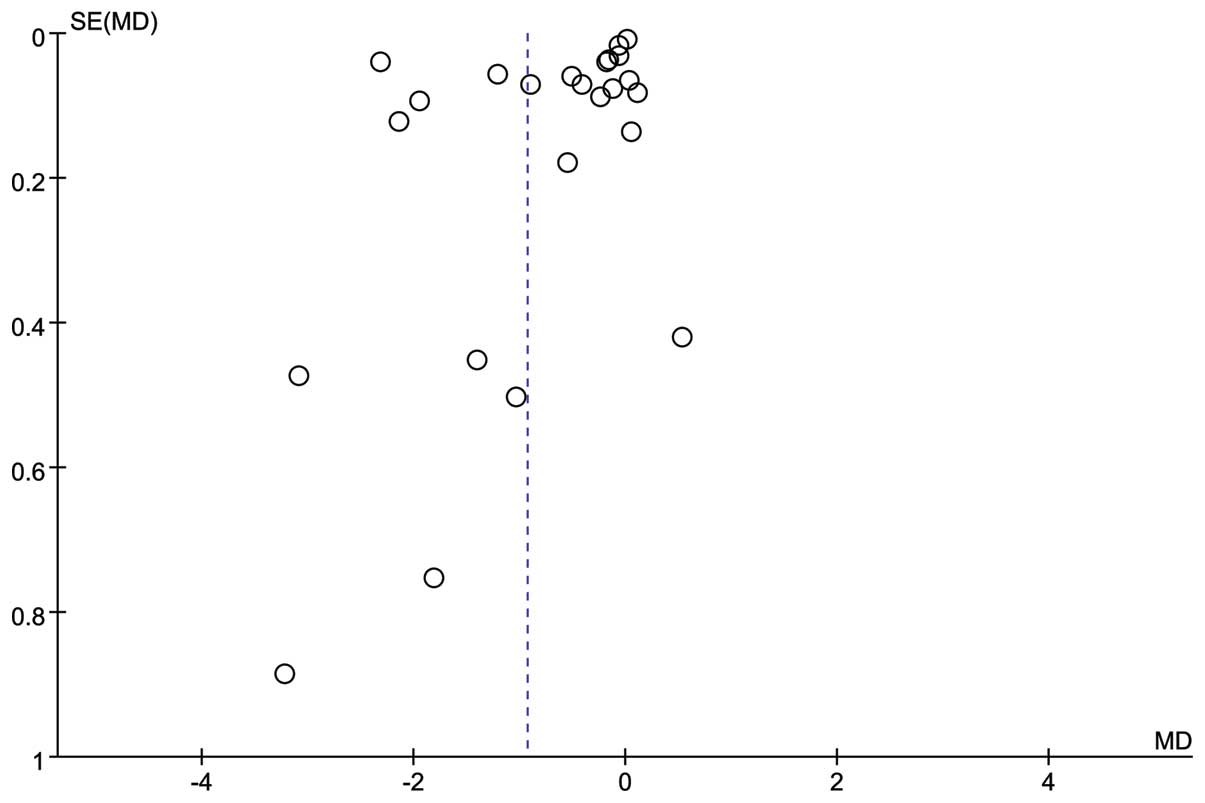|
1
|
Bellomo R, Kellum JA and Ronco C: Acute
kidney injury. Lancet. 380:756–766. 2012. View Article : Google Scholar : PubMed/NCBI
|
|
2
|
Bagshaw SM, George C and Bellomo R: ANZICS
Database Management Committee: Early acute kidney injury and
sepsis: A multicentre evaluation. Crit Care. 12:R472008. View Article : Google Scholar : PubMed/NCBI
|
|
3
|
Waikar SS, Liu KD and Chertow GM:
Diagnosis, epidemiology and outcomes of acute kidney injury. Clin J
Am Soc Nephrol. 3:844–861. 2008. View Article : Google Scholar : PubMed/NCBI
|
|
4
|
Wald R, Quinn RR, Luo J, Li P, Scales DC,
Mamdani MM and Ray JG: University of Toronto Acute Kidney Injury
Research Group: Chronic dialysis and death among survivors of acute
kidney injury requiring dialysis. JAMA. 302:1179–1185. 2009.
View Article : Google Scholar : PubMed/NCBI
|
|
5
|
Qian H, Yang H, Xu W, Yan Y, Chen Q, Zhu
W, Cao H, Yin Q, Zhou H, Mao F and Chen Y: Bone marrow mesenchymal
stem cells ameliorate rat acute renal failure by differentiation
into renal tubular epithelial-like cells. Int J Mol Med.
22:325–332. 2008.PubMed/NCBI
|
|
6
|
Gao J, Liu R, Wu J, Liu Z, Li J, Zhou J,
Hao T, Wang Y, Du Z, Duan C and Wang C: The use of chitosan based
hydrogel for enhancing the therapeutic benefits of adipose-derived
MSCs for acute kidney injury. Biomaterials. 33:3673–3681. 2012.
View Article : Google Scholar : PubMed/NCBI
|
|
7
|
Duffield JS, Park KM, Hsiao LL, Kelley VR,
Scadden DT, Ichimura T and Bonventre JV: Restoration of tubular
epithelial cells during repair of the postischemic kidney occurs
independently of bone marrow-derived stem cells. J Clin Invest.
115:1743–1755. 2005. View
Article : Google Scholar : PubMed/NCBI
|
|
8
|
Tögel F, Hu Z, Weiss K, Isaac J, Lange C
and Westenfelder C: Administered mesenchymal stem cells protect
against ischemic acute renal failure through
differentiation-independent mechanisms. Am J Physiol Renal Physiol.
289:F31–F42. 2005. View Article : Google Scholar : PubMed/NCBI
|
|
9
|
Milwid JM, Ichimura T, Li M, Jiao Y, Lee
J, Yarmush JS, Parekkadan B, Tilles AW, Bonventre JV and Yarmush
ML: Secreted factors from bone marrow stromal cells upregulate
IL-10 and reverse acute kidney injury. Stem Cells Int.
2012:3920502012. View Article : Google Scholar : PubMed/NCBI
|
|
10
|
Bi B, Schmitt R, Israilova M, Nishio H and
Cantley LG: Stromal cells protect against acute tubular injury via
an endocrine effect. J Am Soc Nephrol. 18:2486–2496. 2007.
View Article : Google Scholar : PubMed/NCBI
|
|
11
|
Bruno S, Grange C, Deregibus MC, Calogero
RA, Saviozzi S, Collino F, Morando L, Busca A, Falda M, Bussolati
B, et al: Mesenchymal stem cell-derived microvesicles protect
against acute tubular injury. J Am Soc Nephrol. 20:1053–1067. 2009.
View Article : Google Scholar : PubMed/NCBI
|
|
12
|
Gheisari Y, Ahmadbeigi N, Naderi M,
Nassiri SM, Nadri S and Soleimani M: Stem cell-conditioned medium
does not protect against kidney failure. Cell Biol Int. 35:209–213.
2011. View Article : Google Scholar : PubMed/NCBI
|
|
13
|
Xing L, Cui R, Peng L, Ma J, Chen X, Xie
RJ and Li B: Mesenchymal stem cells, not conditioned medium,
contribute to kidney repair after ischemia-reperfusion injury. Stem
Cell Res Ther. 5:1012014. View
Article : Google Scholar : PubMed/NCBI
|
|
14
|
Camussi G, Deregibus MC, Bruno S,
Cantaluppi V and Biancone L: Exosomes/microvesicles as a mechanism
of cell-to-cell communication. Kidney Int. 78:838–848. 2010.
View Article : Google Scholar : PubMed/NCBI
|
|
15
|
Baglio SR, Pegtel DM and Baldini N:
Mesenchymal stem cell secreted vesicles provide novel opportunities
in (stem) cell-free therapy. Front Physiol. 3:3592012. View Article : Google Scholar : PubMed/NCBI
|
|
16
|
Wang Y, He J, Pei X and Zhao W: Systematic
review and meta-analysis of mesenchymal stem/stromal cells therapy
for impaired renal function in small animal models. Nephrology
(Carlton). 18:201–208. 2013. View Article : Google Scholar : PubMed/NCBI
|
|
17
|
van der Spoel TI, Jansenof Lorkeers SJ,
Agostoni P, van Belle E, Gyöngyösi M, Sluijter JP, Cramer MJ,
Doevendans PA and Chamuleau SA: Human relevance of pre-clinical
studies in stem cell therapy: Systematic review and meta-analysis
of large animal models of ischaemic heart disease. Cardiovasc Res.
91:649–658. 2011. View Article : Google Scholar : PubMed/NCBI
|
|
18
|
Bruno S, Grange C, Collino F, Deregibus
MC, Cantaluppi V, Biancone L, Tetta C and Camussi G: Microvesicles
derived from mesenchymal stem cells enhance survival in a lethal
model of acute kidney injury. PLoS One. 7:e331152012. View Article : Google Scholar : PubMed/NCBI
|
|
19
|
Gatti S, Bruno S, Deregibus MC, Sordi A,
Cantaluppi V, Tetta C and Camussi G: Microvesicles derived from
human adult mesenchymal stem cells protect against
ischaemia-reperfusion-induced acute and chronic kidney injury.
Nephrol Dial Transplant. 26:1474–1483. 2011. View Article : Google Scholar : PubMed/NCBI
|
|
20
|
Kilpinen L, Impola U, Sankkila L, Ritamo
I, Aatonen M, Kilpinen S, Tuimala J, Valmu L, Levijoki J and
Finckenberg P: Extracellular membrane vesicles from umbilical cord
blood-derived MSC protect against ischemic acute kidney injury, a
feature that is lost after inflammatory conditioning. J Extracell
Vesicles. 2:2013. View Article : Google Scholar : PubMed/NCBI
|
|
21
|
Kim JH, Park DJ, Yun JC, Jung MH, Yeo HD,
Kim HJ, Kim DW, Yang JI, Lee GW, Jeong SH, et al: Human adipose
tissue-derived mesenchymal stem cells protect kidneys from
cisplatin nephrotoxicity in rats. Am J Physiol Renal Physiol.
302:F1141–F1150. 2012. View Article : Google Scholar : PubMed/NCBI
|
|
22
|
Reis LA, Borges FT, Simões MJ, Borges AA,
Sinigaglia-Coimbra R and Schor N: Bone marrow-derived mesenchymal
stem cells repaired but did not prevent gentamicin-induced acute
kidney injury through paracrine effects in rats. PLoS One.
7:e440922012. View Article : Google Scholar : PubMed/NCBI
|
|
23
|
Zarjou A, Kim J, Traylor AM, Sanders PW,
Balla J, Agarwal A and Curtis LM: Paracrine effects of mesenchymal
stem cells in cisplatin-induced renal injury require heme
oxygenase-1. Am J Physiol Renal Physiol. 300:F254–F262. 2011.
View Article : Google Scholar : PubMed/NCBI
|
|
24
|
Zhang G, Zou X, Miao S, Chen J, Du T,
Zhong L, Ju G, Liu G and Zhu Y: The anti-oxidative role of
micro-vesicles derived from human wharton-jelly mesenchymal stromal
cells through NOX2/gp91(phox) suppression in alleviating renal
ischemia-reperfusion injury in rats. PLoS One. 9:e921292014.
View Article : Google Scholar : PubMed/NCBI
|
|
25
|
Zhou Y, Xu H, Xu W, Wang B, Wu H, Tao Y,
Zhang B, Wang M, Mao F and Yan Y: Exosomes released by human
umbilical cord mesenchymal stem cells protect against
cisplatin-induced renal oxidative stress and apoptosis in vivo and
in vitro. Stem Cell Res Ther. 4:342013. View Article : Google Scholar : PubMed/NCBI
|
|
26
|
Zou X, Zhang G, Cheng Z, Yin D, Du T, Ju
G, Miao S, Liu G, Lu M and Zhu Y: Microvesicles derived from human
Wharton's Jelly mesenchymal stromal cells ameliorate renal
ischemia-reperfusion injury in rats by suppressing CX3CL1. Stem
Cell Res Ther. 5:402014. View
Article : Google Scholar : PubMed/NCBI
|
|
27
|
Fisher MB and Mauck RL: Tissue engineering
and regenerative medicine: recent innovations and the transition to
translation. Tissue Engineering Part B: Reviews. 19:1–13. 2013.
View Article : Google Scholar
|
|
28
|
Wei X, Yang X, Han ZP, Qu FF, Shao L and
Shi YF: Mesenchymal stem cells: A new trend for cell therapy. Acta
Pharmacol Sin. 34:747–754. 2013. View Article : Google Scholar : PubMed/NCBI
|
|
29
|
Lim PK, Bliss SA, Patel SA, Taborga M,
Dave MA, Gregory LA, Greco SJ, Bryan M, Patel PS and Rameshwar P:
Gap junction-mediated import of microRNA from bone marrow stromal
cells can elicit cell cycle quiescence in breast cancer cells.
Cancer Res. 71:1550–1560. 2011. View Article : Google Scholar : PubMed/NCBI
|
|
30
|
Rubio D, Garcia S, Paz MF, De la Cueva T,
Lopez-Fernandez LA, Lloyd AC, Garcia-Castro J and Bernad A:
Molecular characterization of spontaneous mesenchymal stem cell
transformation. PLoS One. 3:e13982008. View Article : Google Scholar : PubMed/NCBI
|
|
31
|
Camussi G, Deregibus MC and Cantaluppi V:
Role of stem-cell-derived microvesicles in the paracrine action of
stem cells. Biochem Soc Trans. 41:283–287. 2013. View Article : Google Scholar : PubMed/NCBI
|
|
32
|
Du T, Cheng J, Zhong L, Zhao XF, Zhu J,
Zhu YJ and Liu GH: The alleviation of acute and chronic kidney
injury by human Wharton's jelly-derived mesenchymal stromal cells
triggered by ischemia-reperfusion injury via an endocrine
mechanism. Cytotherapy. 14:1215–1227. 2012. View Article : Google Scholar : PubMed/NCBI
|
|
33
|
Sandercock P and Roberts I: Systematic
reviews of animal experiments. Lancet. 360:5862002. View Article : Google Scholar : PubMed/NCBI
|
|
34
|
Horn J, De Haan R, Vermeulen M, Luiten P
and Limburg M: Nimodipine in animal model experiments of focal
cerebral ischemia: A Systematic Review. Stroke. 32:2433–2438. 2001.
View Article : Google Scholar : PubMed/NCBI
|
|
35
|
Roberts I, Kwan I, Evans P and Haig S:
Does animal experimentation inform human healthcare? Observations
from a systematic review of international animal experiments on
fluid resuscitation. BMJ. 324:474–476. 2002. View Article : Google Scholar : PubMed/NCBI
|
|
36
|
Biondi-Zoccai GG, Abbate A, Parisi Q,
Agostoni P, Burzotta F, Sandroni C, Zardini P and Biasucci LM: Is
vasopressin superior to adrenaline or placebo in the management of
cardiac arrest? A meta-analysis. Resuscitation. 59:221–224. 2003.
View Article : Google Scholar : PubMed/NCBI
|
|
37
|
Verstraete M: Value and limitation of
meta-analysis. Pathophysiol Haemost Thromb. 32:278–281. 2002.
View Article : Google Scholar : PubMed/NCBI
|

















